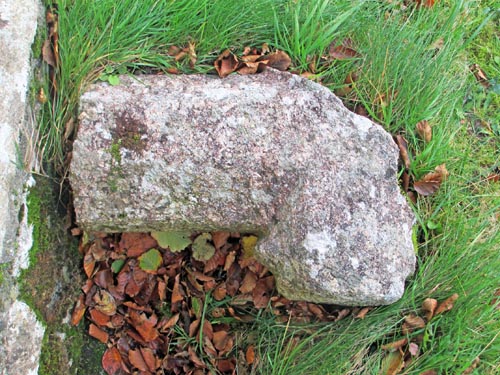| Harford Churchyard Cross Head |
 Location:
Lying beside the church
wall immediately to the left of the porch. Location:
Lying beside the church
wall immediately to the left of the porch.O/S Grid Ref: SX/63823/59472 Longitude/Latitude (Degrees+/-): -3.91822/50.41928 Map location: Click here to view map. Purpose: The original purpose of this cross is unknown. Size: This section of a cross head is 1 foot 8 inches (0.51 metres) long and 10 inches (0.25 metres) across the shaft and the one remaining arm. The depth of the shaft is 9 inches (0.23 metres). The arm juts out from the shaft by 4 inches (0.10 metres) and is 9½ inches (0.24 metres) high, with a depth of 9 inches (0.23 metres). Information: It is not known where this piece of a cross head came from or where the cross would have originally stood. From looking at the head, I would judge that it is more modern than the rugged and substantial Harford Cross that stands in the same churchyard, near the main entrance gate. My guess would be that it once served as a waymarking cross and, after being found in this damaged state, the head was rescued and brought into the churchyard for safekeeping. The cross head shows a spur projecting out from under, and possibly above, the remaining arm which is very similar to the arms of both the Spurrell's Cross and the cross head on display in the porch of Ermington Church. This ornate feature is unusual in the various crosses found around the moor, which generally tend to be more rugged and practical, than ornate. It maybe that, within Dartmoor, it is a unique feature of a particular stonemason who was based in this locality.
Immediately outside the main entrance gate to the churchyard and on the opposite side of the road, a pipe protrudes from the roadside wall supplying a constant flow of water into a semicircular stone trough on the ground below. The property behind the wall is Harford Ash Farm and the probablility is that the water originates from a spring somewhere within the farm. It certainly provides a good supply of fresh water for any animals as they are moved up and down the lane. Our thanks to Mark Fenlon for bringing this cross head to our attention. |